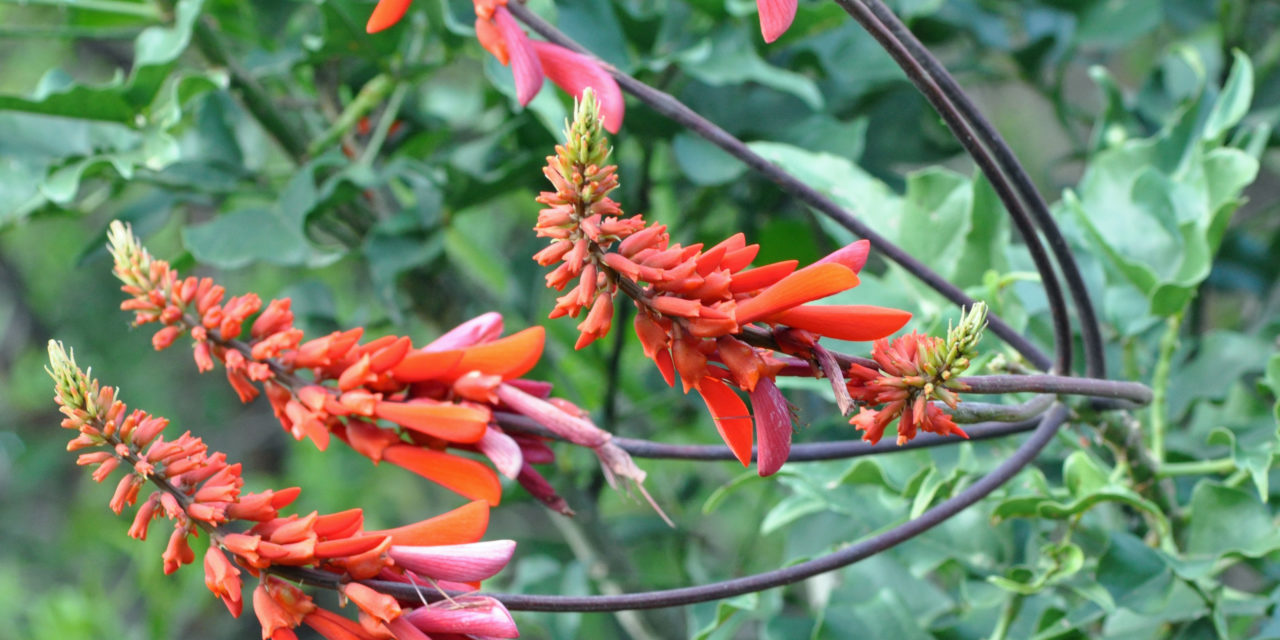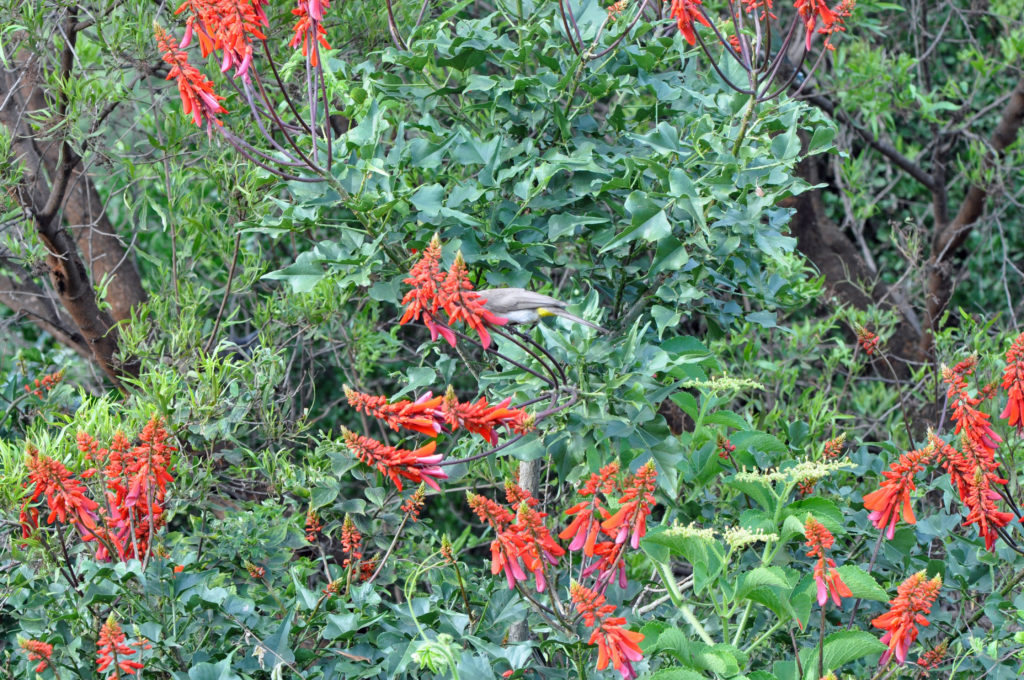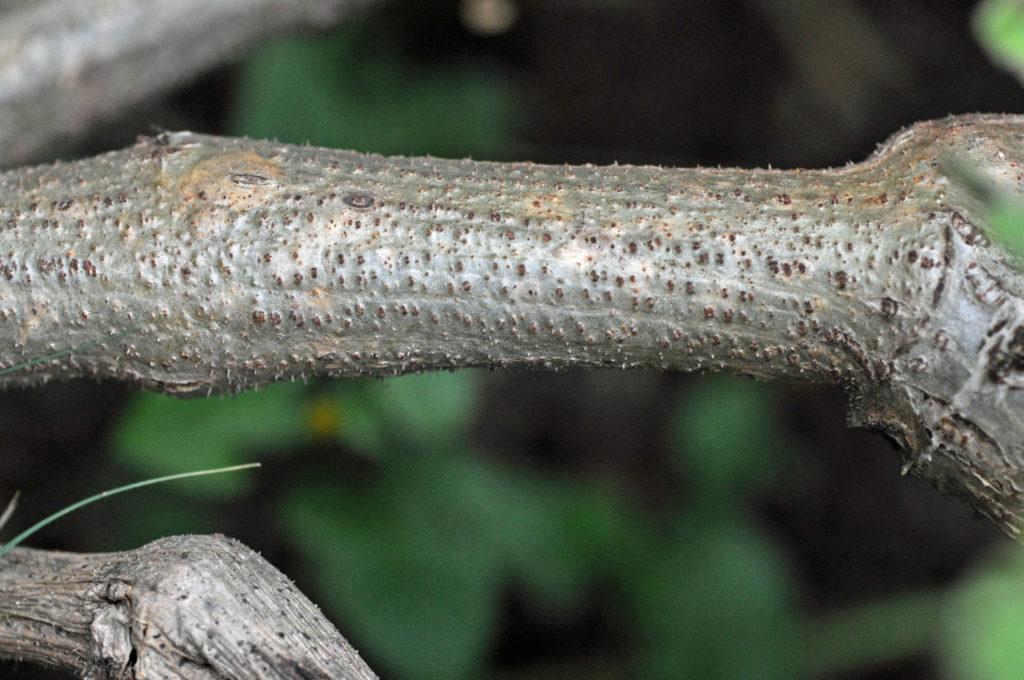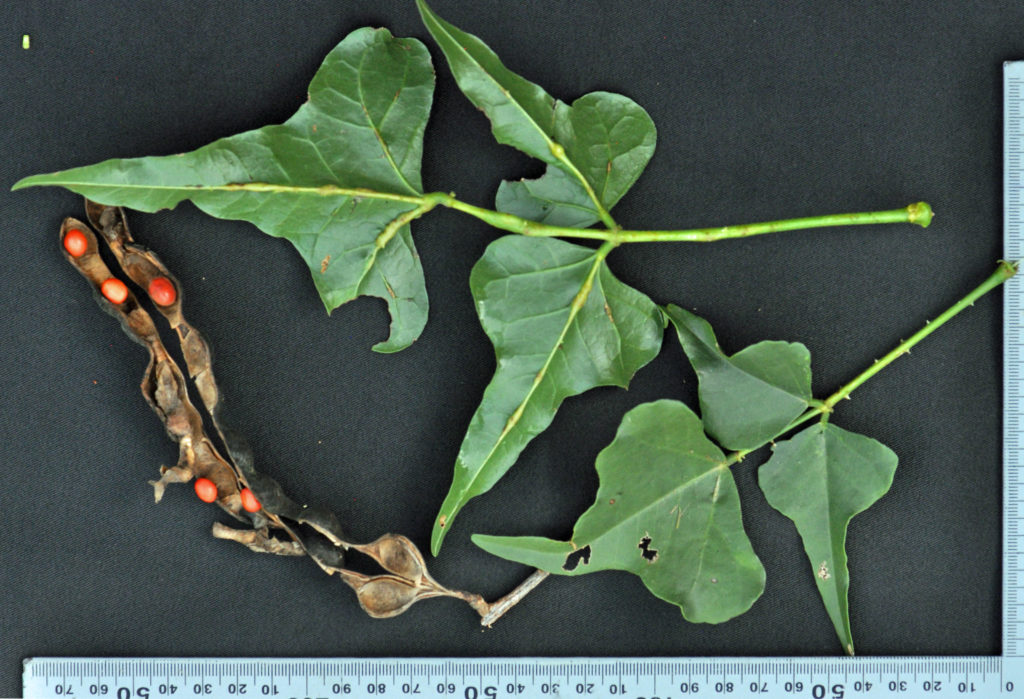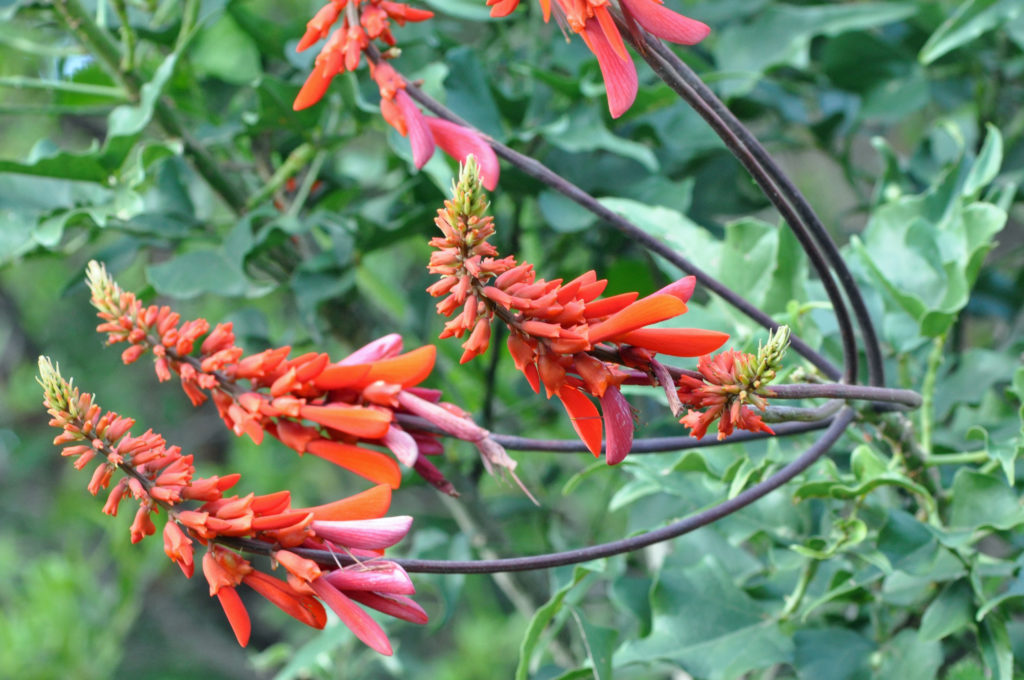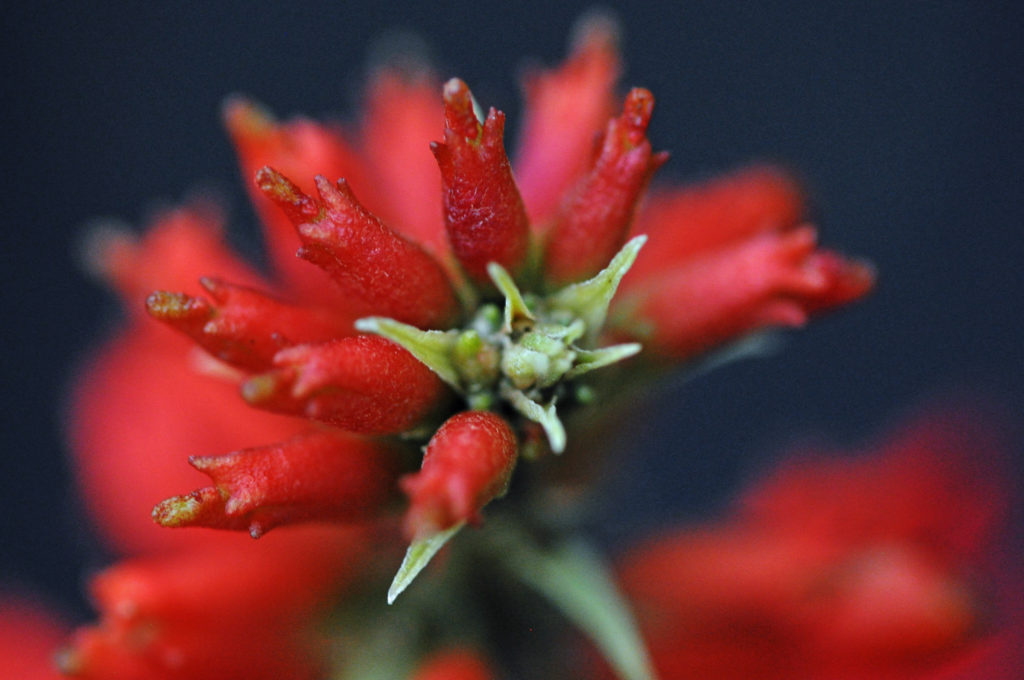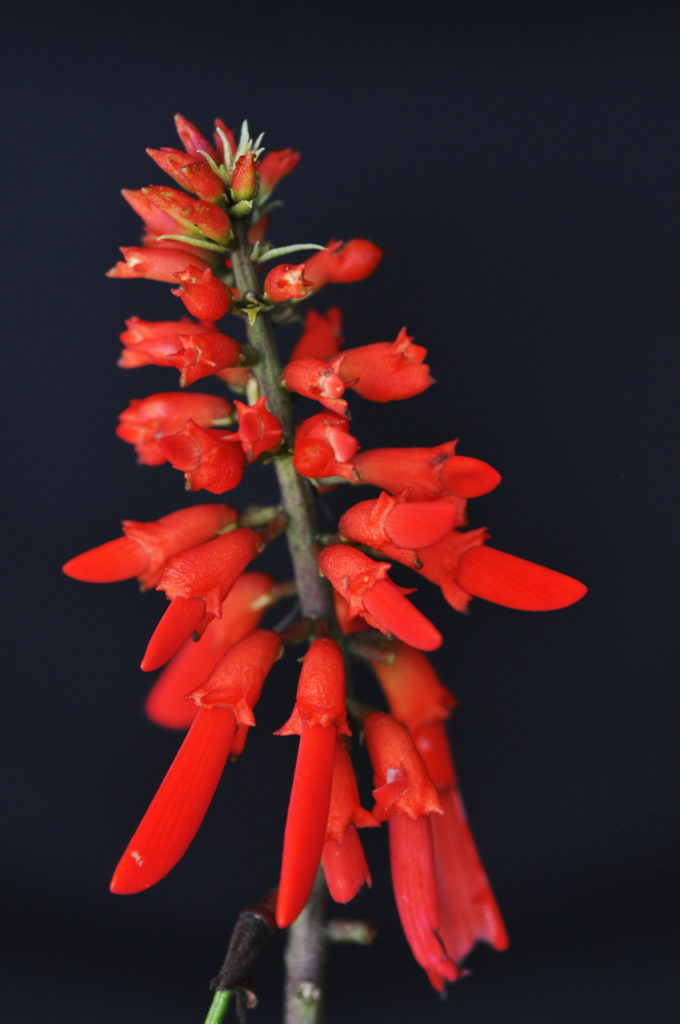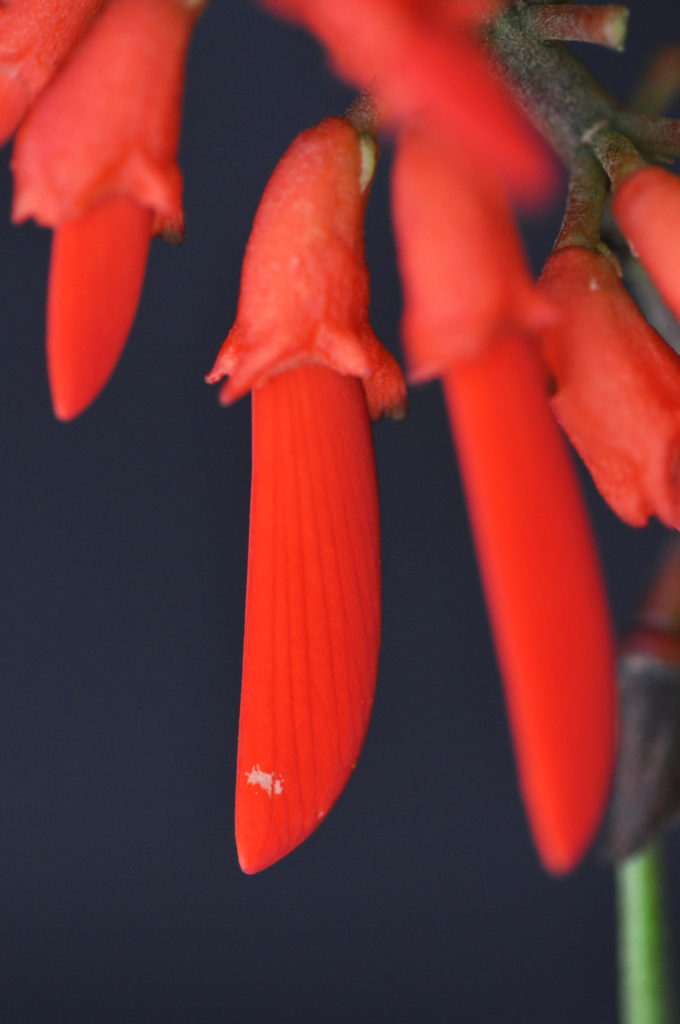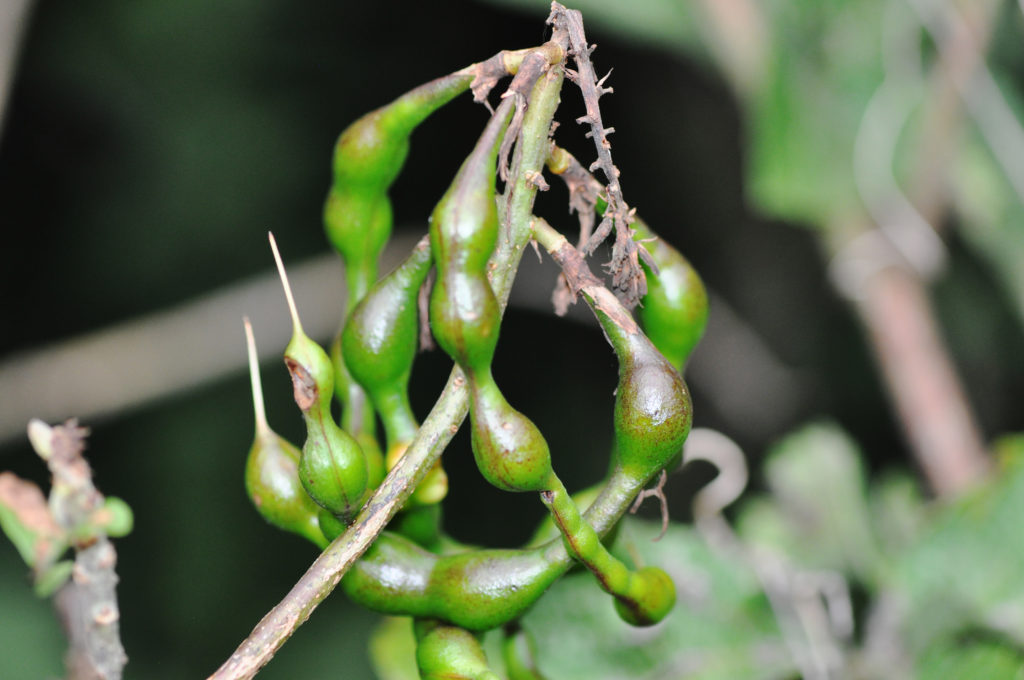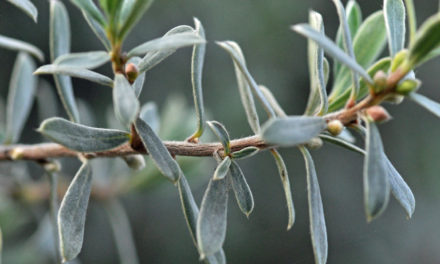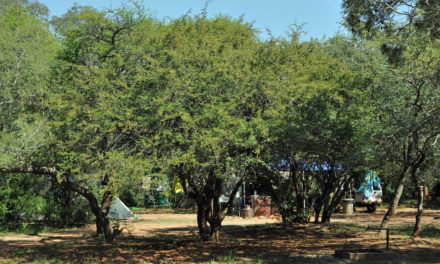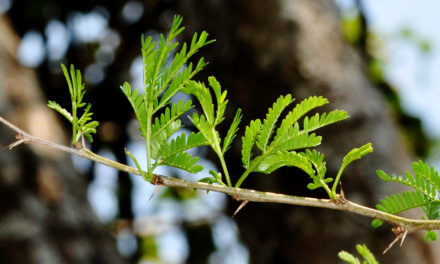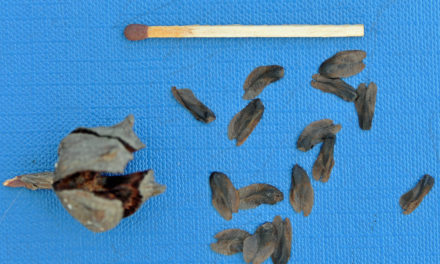General Info – summary
This deciduous, dwarf corral Tree is up to 4m high but is usually a multi-stemmed shrub with smoothish bark and tuberous roots. The trifoliate, olive green Leaves have prickles, are up to 30cm long and leaflets are 3-veined from the base. Late flowering, bisexual scarlet Flowers are zygomorphic, & develop with the new leaves. Ten stamens surround the superior ovary. Fruit is a moniliform pod with orange/red seeds.
Description
Erythrina humeana
Previous Names: Erythrina humei, Erythrina princeps.
SA Tree No. 243.1.
Common names: (Afr) Klein-koraalboom, Tambukidoring. (Eng) Dwarf Coral Tree. (isiXhosa) Umsintsane, Utambuki. (isiZulu) Ikati, Umsinsana. (Northern Sotho) Mokhupye. (siSwati) Umdvumbula, Umsinsana.
Family: Fabaceae, or Leguminosae (Pea, bean or legume family). After the Orchidaceae and the Asteraceae, the Fabaceae is the third largest Angiosperm (flowering plants) family with 700+ genera and close to 20 000 species. Local Tree genera on this website include Acacia (Vauchellia, Senegalia), Albizia, Bauhinia, Bolusanthus, Burkea, Calpurnia, Colophospermum, Cordyla, Cyclopia, Dichrostachys, Erythrina, Erythrophleum, Faidherbia, Indigofera, Mundulea, Peltophorum, Philenoptera, Piliostigma, Schotia and Xanthocercis. The Fabaceae are recognisable by their fruit and by their pinnately compound Leaves. Leaves may also be simple – even bilobed and usually have stipules – some of which may be spinescent. Leaflets are usually entire. Flowers are bisexual and bracteate. Regular flowers usually have 4-5 sepals and the same number of petals. Irregular flowers have 4-5 sepals and 5 or less petals. Stamens have anthers that have 2 pollen sacs and there are usually at least twice the number of stamens as petals – often 10. The superior Ovary has 1 locule containing 1 or more ovules. The Stigma and Style are simple. The single carpel develops into the Fruit, which is usually a pod. The fallen pods may break into segments. Seeds vary.
Name derivation: Erythrina from the Greek “erythros” meaning red – referring to the flower colour. humeana – in honour of Sir Abraham Hume (1749-1838) who had a famous garden in England – with many exotic plants. The genus Erythrina has about 160 species with 9 in southern Africa and 6 in South Africa.
Conservation: National Status: L C. (Least Concern). Assessment: 2005 (W. Foden and L. Potter).
Tree
This dwarf coral Tree (photo 385), with a sparse crown, may reach 4m in height but it is usually a multi-stemmed shrub. The smoothish, light grey Bark has scattered short sharp, prickles. The grey-green Branchlets (small branches or division of branches – especially a terminal division; usually applied to branches of the current or preceding year) have scattered, hooked Prickles and Lenticels (usually raised corky oval or elongated area on the plant that allows the uncontrolled interchange of gases with the environment – photo 1007). During spring, a number of branches may develop from the tuberous roots.
- 385. 2016/12/22 Walter Sisulu NBG. Photo: David Becking.
- 1007. 2018/03/07 Walter Sisulu NBG. Photo: David Becking.
Leaves
On this deciduous tree, the Leaf shape is variable but often markedly triangular. The 3-lobed Leaves are trifoliate (compound leaves with 3-leaflets – photo 393). The terminal (central) leaflet is usually the largest and up to 13 x 12cm. Lateral leaflets are slightly shorter. Leaflets are dark olive green and shiny above and less so below (photo 393). Each leaflet is 3-veined from the base (photo 393). The leaflet Apex has a long slender tip and appears almost like an arrowhead (photo 393). The Base is rounded, and a small pairs of glands may be visible at the base of each leaflet. The Margin is wavy but entire (with a continuous margin). The Midrib, Lateral veins, Petioles (leaf stalks) and Petiolules (stalks of leaflets) all have small, scattered hooked prickles. Stipules (basal appendages of the petiole) are broad or narrow and fall early.
- 393. 2016/12/22 Walter Sisulu NBG. Photo: David Becking.
Flowers
This is the only coral tree to bloom relatively late – in midsummer (Sep-Mar). This late flowering is distinctive in identification. The Flowers, including the calyx (photo 1012), are a deep, brilliant scarlet and up to 10cm long. They develop together, or after the new leaves, in long stalked Racemes (simple elongated inflorescences with stalked flowers – photo 1010 – that open in succession towards the apex – photo 387). The racemes are up to 50cm long and are located at branch ends (photo 387). A long visible Peduncle (stalk holding the whole inflorescence) is present – photo 387. Flowers have visible Pedicels (stalks of single flowers in a cluster – photo 1010). Individual flowers are bisexual and zygomorphic (irregular flower with the corolla divisible into 2 equal halves in one plane only – here from top to bottom). Green Bracts (modified specialised leaves) are present below young flowers (photo 1014 & 1010) and soon fall. The scarlet (photo 1010) Calyx has Sepals that are joined to form a tube, which is split below. It ends with short distinctive lobes (photo 1010 & 1012). The scarlet Vexillum (the standard or banner Petal, the broad upper petal of the Corolla) overarches the other petals (photo 1012). The 10 Stamens have uniform Anthers and are enclosed within the vexillum. There is a single Pistil (a unit of the Gynoecium, the female element of the flower, composed of the Ovary, Style and Stigma). The superior stalked, linear Ovary is hairy and has many ovules. The incurved and terete (circular in cross-section) Style ends in a small terminal Stigma (Sep-Apr).
- 387. 2016/12/22 Walter Sisulu NBG. Photo: David Becking.
- 1014. 2018/03/07 Walter Sisulu NBG. Photo: David Becking.
- 1010. 2018/03/07 Walter Sisulu NBG. Photo: David Becking.
- 1012. 2018/03/07 Walter Sisulu NBG. Photo: David Becking.
Fruit
The initially green Fruit (photo 1009), which matures to a dark purple or black (photo 393 under Leaves), is a thin walled, hairless Pod (a dry dehiscent fruit) that is up to 16cm long and Moniliform (deeply constricted between the seeds (photo 1009). In this photo, the remains of the Style are still visible. Although the pods are dehiscent, the oval, somewhat flattened orange-red Seeds may remain on the tree (in pods) until after the new flowers appear – the following year (photo 393– under Leaves). Orange Seeds have a black spot indicating the place of past attachment to the ovary wall. (Dec-May).
- 1009. 2018/03/07 Walter Sisulu NBG. Photo: David Becking.
Distribution & Ecology
These plants grow in dense dry scrub (general term for vegetation dominated by shrubs, i.e. low, woody plants, which typically forms an intermediate community between grass or heath and high forest). This attractive plant occurs in the Eastern Cape and KwaZulu-Natal e.g., the dense dry scrub (general term for vegetation dominated by shrubs, i.e., low, woody plants, which typically forms an intermediate community between grass or heath and high forest). These plants grow in the Muden Valley (Central KwaZulu-Natal) and the slopes of the Drakensberg through Mpumalanga, Limpopo, Swaziland and central as well as southern Mozambique. They are Endemic (restricted to a particular geographic location) in southern Africa and occur in dry wooded grassland, bushveld (a sub-tropical woodland ecoregion of southern Africa) and thornveld. They are also found on rocky mountain slopes and coastal dunes. They do not occur in the Northern or Western Cape. Distribution ranges from sea level to mountain foothills e.g., the low to medium altitudes of the Drakensberg Mountain Range. The flowers produce a lot of Nectar attracting birds including sunbirds. This is the only coral tree to bloom relatively late in midsummer and is distinctive.
Ethnobotany
These plants are quick growing but frost sensitive. Propagation is best in spring – by seeds or cuttings. Once established, the plant develops large tuberous roots and do not require watering in winter. Local medicine makes use of the roots and bark. This is an attractive garden prospect especially for a small garden. This tree is the emblem of Prince Alfred’s Guard – the old Eastern Province Regiment.
References
Boon, R. 2010. Pooley’s Trees of eastern South Africa. Flora and Fauna Publications Trust, Durban.
Burrows, J.E., Burrows, S.M., Lotter, M.C. & Schmidt, E. 2018. Trees and Shrubs Mozambique. Publishing Print Matters (Pty) Ltd. Noordhoek, Cape Town.
Coates Palgrave, M. 2002. Keith Coates Palgrave Trees of Southern Africa, edn 3. Struik, Cape Town.
Foden, W. & Potter, L. 2005. Erythrina humeana Spreng. National Assessment: Red List of South African Plants version 2020.1. Accessed on 2023/05/04.
Ginn, P. J, McIlleron, W.G, & Mimstein, P. le S. 1991. The Complete Book of South African Birds. Struik, Cape Town/Singapore.
Lawrence, G. H. M, 1951. Taxonomy of Vascular Plants. The Macmillan Company, New York. Tenth Printing 1965.
Palmer, E. & Pitman, N. 1972. Trees of southern Africa. Balkema, Amsterdam, Cape Town.
Schmidt, S. Lotter, M. & McCleland, W. 2002. Trees and Shrubs of Mpumalanga and the Kruger National Park.
van Wyk, B. & van Wyk, P. 1997 Field guide to Trees of Southern Africa, Struik, Cape Town.
http://www.plantzafrica.com/plantefg/erythrinahumeana.htm
http://posa.sanbi.org/flora/browse.php?src=SP

